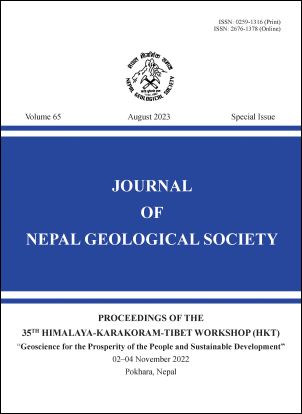Connecting innovation and source conservation for meeting water needs
DOI:
https://doi.org/10.3126/jngs.v65i01.57754Keywords:
Hydrogeology, research, conservation, plan, solar MUSAbstract
Springs are the major sources of water in Nepal, but the springs are drying up fast due to, among others, climate change, ill-engineered infrastructure and associated disasters. A huge sum of money is invested in water supply projects and a significant percentage of those have become nonfunctional due to source drying. Most of the projects consider the supply side only- not sustainability. By that, the scarce public investment is wasted. Hydrogeological aspects including climate change, and source conservation were never been realized. Once the sources dry up, projects become redundant. People look for alternative sources requiring scarce public investment. Therefore, the Government of Nepal and development partners like Renewable World (RW) concluded that the sustainability of water projects is crucial and must be considered in the initial phases of project development. It can be assisted and achieved by hydrogeological evidence-based water source conservation planning. To implement it, an interdisciplinary research team of Nepal Water Conservation Foundation and RW conducted a hydrogeological study including the climate impacts and participatory planning applying different sets of tools and methods applied in social and natural sciences such as hydrogeological study, key informant interviews, focused group discussions and policy assessment. Consequently, 10 site-specific source protection and conservation plans for solar MUS schemes were developed. The study found four types of variables: (i) Precipitation and temperature: There was no significant impact of climate change in terms of rise in temperature and precipitation; (ii) Problems related to conservation: The major problems included drying up and displacement of springs by flood, landslide and road constructions; pollution through agricultural runoff, livestock grazing, and contamination by pesticides and chemical fertilizers; disappearance or conversion of traditional wallowing/recharge ponds; contamination and damage by flood; (iii) Innovation: Even a small innovation like Solar MUS can contribute in people’s life significantly through lifting water from downhill sources; (iv) Planning: Source protection and conservation plan can be formulated democratically and owned by local government and water user groups and implemented jointly.
Downloads
Downloads
Published
How to Cite
Issue
Section
License
© Nepal Geological Society




